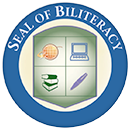The Seal of Biliteracy
In a relatively short period of time, the Seal of Literacy has evolved from a grassroots movement to a nationwide phenomenon, according to Lead with Languages. So just what is the Seal of Biliteracy that has made such a splash in recent years?

Basically, the Seal of Biliteracy is a terrific language proficiency award program for high school students recognizing kids who have attained proficiency in two languages or more, states the Seal of Biliteracy organization. The award is in the form of a seal that is affixed on the student’s diploma upon graduating.
There are a number of undeniable benefits to earning it. First, it encourages kids to pursue learning a second language. Second, along with honoring the efforts that it took to learn another language, the seal is proudly displayed for all to see, and that can be highly attractive to colleges and future employers. Overall, it’s a unique distinction for students who have obtained it. Not to mention, it could really expand the global job market for young Americans now and in the future.
The first Seal of Biliteracy was created back in 2008 as part of a grassroots effort by the educational advocacy organization, Californians Together. Then, in spring 2012, more than 10,000 fortunate California graduates received it on their diploma. The award is an equal opportunity seal, too, as it’s granted to not just English language learners (ELL) but to all students who meet the criteria.
As it stands now, 25 states and Washington DC have approved using it, reports the state legislature organization, NCSL. In addition, five states are in the beginning stages of the formation process, and six have pending legislation to enact it into law.
Along with the distinction of the Seal of Biliteracy gracing students’ diplomas, finding educational programs that support ELL students’ first language, such as The Latino Family Literacy Project, can make an enormous difference on their overall academic and language acquisition success.
